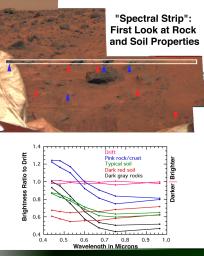
|
First Look at Rock & Soil Properties
- Click the image above for a larger view
- Full-Res JPEG (989 x 1245) (144.8 kB)
- Full-Res TIFF (989 x 1245) (1.6 MB)
Caption:
The earliest survey of spectral properties of the rocks and soils surrounding Pathfinder was acquired as a narrow strip covering the region just beyond the where the rover made its egress from the lander. The wavelength filters used, all in the binocular camera's right eye, cover mainly visible wavelengths. These data reveal at least five kinds of rocks and soil in the immediate vicinity of the lander. All of the spectra are ratioed to the mean spectrum of bright red drift to highlight the differences. Different occurrences of drift (pink spectra) are closely similar. Most of the rocks (black spectra) have a dark gray color, and are both darker and less red than the drift, suggesting less weathering. Typical soils (green spectra) are intermediate in properties to the rocks and drift. Both these data and subsequent higher resolution images show that the typical soil consists of a mixture of drift and small dark gray particles resembling the rock. However, two other kinds of materials are significantly different from the rocks and drift. Pinkish or whitish pebbles and crusts on some of the rocks (blue spectra) are brighter in blue light and darker in near-infrared light than is the drift, and they lack the spectral characteristics closely associated with iron minerals. Dark red soils in the lee of several rocks are about as red as the drift, but consistently darker. The curvature in the spectrum at visible wavelengths suggests either more ferric iron minerals than in the drift or a larger particle size.
Background Info:
Mars Pathfinder is the second in NASA's Discovery program of low-cost spacecraft with highly focused science goals. The Jet Propulsion Laboratory, Pasadena, CA, developed and manages the Mars Pathfinder mission for NASA's Office of Space Science, Washington, D.C. The Imager for Mars Pathfinder (IMP) was developed by the University of Arizona Lunar and Planetary Laboratory under contract to JPL. Peter Smith is the Principal Investigator. JPL is an operating division of the California Institute of Technology (Caltech).
Photojournal note: Sojourner spent 83 days of a planned seven-day mission exploring the Martian terrain, acquiring images, and taking chemical, atmospheric and other measurements. The final data transmission received from Pathfinder was at 10:23 UTC on September 27, 1997. Although mission managers tried to restore full communications during the following five months, the successful mission was terminated on March 10, 1998.
Cataloging Keywords:
| Name | Value | Additional Values |
|---|---|---|
| Target | Mars | |
| System | ||
| Target Type | Planet | |
| Mission | Mars Pathfinder (MPF) | |
| Instrument Host | Mars Pathfinder Lander | |
| Host Type | Lander | |
| Instrument | Imager for Mars Pathfinder (IMP) | |
| Detector | ||
| Extra Keywords | Atmosphere, Color, Infrared | |
| Acquisition Date | ||
| Release Date | 1997-07-22 | |
| Date in Caption | ||
| Image Credit | NASA/JPL/Johns Hopkins University | |
| Source | photojournal.jpl.nasa.gov/catalog/PIA00759 | |
| Identifier | PIA00759 | |
